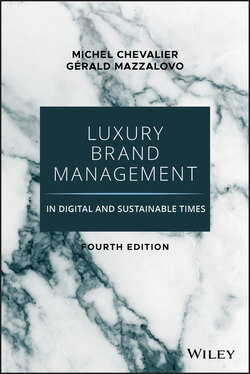Читать книгу Luxury Brand Management in Digital and Sustainable Times - Michel Chevalier - Страница 22
The Brand and Its Manifestations
ОглавлениеAs we just mentioned, discourses about the mechanisms of production of luxury characterize the point of view of operational executives. They are, however, structured by the phenomenon of the brand. It introduced a second and critical dimension in a productive approach to luxury. The brand generates issues that the manager cannot confuse with those of the product itself.
For example, specific qualities are expected from a Hermès scarf, the results of a know-how that can be recognized visually and tactilely and that are the indispensable and defining attributes of Hermès scarves. However, something else is expected: a more intangible supplement, an idea, a prestige that will be called “Hermès”—as a brand or, more precisely, as a brand identity.
There is a sort of “beyond the actual product,” that is the brand and that the product must promote without betrayal. But the product is only one of the possible brand manifestations, making brand management issues even more complex. Advertising, points of sale, store windows, websites, social networks, sponsorships, and so forth are other forms of brand manifestations and not less essential for the promotion of its identity.
Two dimensions of brand identity are usually distinguished: the brand ethics, the intelligible part that is made up of its values, its vision of the world, and its idealized representation; and the brand aesthetics, the sensory part that affects its physical and concrete manifestations or all imaginable interfaces between the brand and its consumers. The aesthetic treatments of the sensory part of the brand participate in the sensitive experience of the brand. The emergence of “lifestyle brands” tells us that this experience spread beyond products, in other areas, such as communication, spaces, or behaviors (see Chapter 8 on creation).
Now that we have split the production side into the brand and its manifestations and the perception side into its social and individual parts, we are able to position all the authors' definitions we have mentioned so far (see Figure 1.2).
Figure 1.2 Positioning of Some Authors on the Analytical Scheme of the Definitions of the Notion of Luxury
Figure 1.3 History of the Semantic Evolution of the Definitions of the Notion of Luxury
In order to close the loop, it remains to revert to the semantic history of the term luxury described earlier and insert the meanings identified in our analytical scheme (see Figure 1.3).
The progressive transformation of the concept becomes more noticeable. A number of modern or postmodern values (referring to lifestyle brands) that characterize contemporary luxury like elitism, hedonism, aesthetic creativity, and seduction can be regrouped within clusters. These meanings are mainly concentrated around social luxury perceptions and the positive connotations of its manifestations: it is a symptom of the growing social importance of luxury, especially through the intermediate luxury consumption, but it also reflects the rise of the brand as its main vehicle—without a doubt, the major and structuring phenomenon of this new market.
